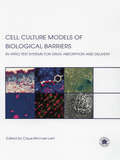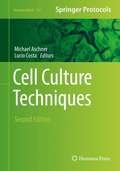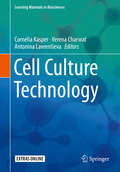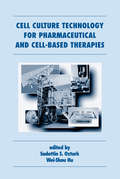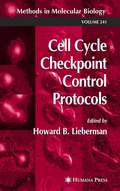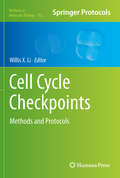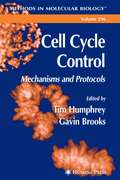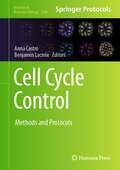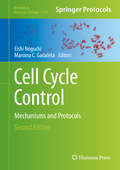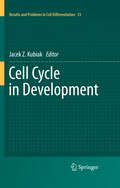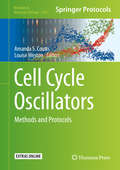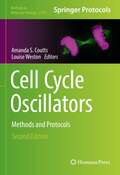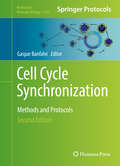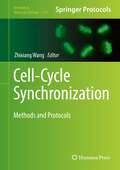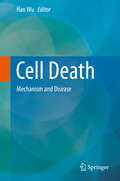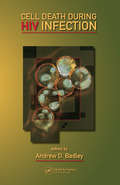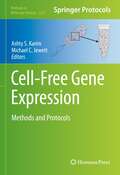- Table View
- List View
Cell Culture Models of Biological Barriers: In vitro Test Systems for Drug Absorption and Delivery
by Claus-Michael LehrOver the past ten years several sophisticated in vitro test systems based on epithelial cell cultures have been introduced in the field of drug delivery. These models have been found to be very useful in characterizing the permeability of drugs across epithelial tissues, and in studying formulations or carrier systems for improved drug delivery and
Cell Culture Techniques (Neuromethods #145)
by Michael Aschner Lucio CostaThis volume discusses the requirements, advantages, and limitations of studying cell culture. The chapters in this book cover topics such as in vitro blood-brain barrier functional assays in human iPSC-based models; neuron-glia interactions examines with in vitro co-culture; epigenetic changes in cultures neurons and astrocytes; rat brain slices; brain punching technique; and using microRNA for in vitro neurotoxicity testing and related disorders. In Neuromethods series style, chapters include the kind of detail and key advice from the specialists needed to get successful results in your laboratory. Authoritative and cutting-edge, Cell Culture Techniques, Second Edition is a valuable resource for students and experiences researchers who are interested in learning more and making risk decisions in this evolving field.
Cell Culture Technology (Learning Materials in Biosciences #4)
by Cornelia Kasper Verena Charwat Antonina LavrentievaThis textbook provides an overview on current cell culture techniques, conditions, and applications specifically focusing on human cell culture. This book is based on lectures, seminars and practical courses in stem cells, tissue engineering, regenerative medicine and 3D cell culture held at the University of Natural Resources and Life Sciences Vienna BOKU and the Gottfried Wilhelm Leibniz University Hannover, complemented by contributions from international experts, and therefore delivers in a compact and clear way important theoretical, as well as practical knowledge to advanced graduate students on cell culture techniques and the current status of research. The book is written for Master students and PhD candidates in biotechnology, tissue engineering and biomedicine working with mammalian, and specifically human cells. It will be of interest to doctoral colleges, Master- and PhD programs teaching courses in this area of research.
Cell Culture Technology for Pharmaceutical and Cell-Based Therapies (Biotechnology and Bioprocessing)
by Sadettin S. OzturkEdited by two of the most distinguished pioneers in genetic manipulation and bioprocess technology, this bestselling reference presents a comprehensive overview of current cell culture technology used in the pharmaceutical industry. Contributions from several leading researchers showcase the importance of gene discovery and genomic technology devel
Cell Cycle Checkpoint Control Protocols (Methods in Molecular Biology #241)
by Howard B. LiebermanA collection of basic cutting-edge techniques for studying the mechanisms underlying cell cycle regulation and checkpoint control. Using mammalian, yeast, and frog systems, these readily reproducible methods can be used to induce cell cycle checkpoints, detect changes in cell cycle progression, identify and analyze genes and proteins that regulate the process, and characterize chromosomal status as a function of cell cycle phase and progression. Each fully tested technique includes step-by-step instructions written by an investigator who routinely performs it, an introduction explaining the principle behind the method, equipment and reagent lists, and tips on troubleshooting and avoiding known pitfalls.
Cell Cycle Checkpoints: Methods and Protocols (Methods in Molecular Biology #782)
by Willis X. LiCell cycle checkpoints control the fidelity and orderly progression of eukaryotic cell division. By controlling the orderly progression of critical cell cycle events such as DNA replication and chromosome segregation and ensuring proper repair of damaged DNA, cell cycle checkpoints function to ensure genome integrity. Mechanisms of checkpoint controls are not only the research focus of investigators interested in mechanisms that regulate the cell cycle, but are also the interests of researchers studying cancer development as it is increasingly clear that loss of cell cycle checkpoints, which leads to genomic instability as a result, is a hallmark of tumorigenesis. Cell Cycle Checkpoints: Methods and Protocols provides detailed descriptions of methodologies currently employed by researchers in the field, including those commonly used in the mammalian, yeast, C. elegans, Drosophila, and Xenopus model systems. Each chapter describes a specific technique or protocol, such as a method to induce cell cycle checkpoints in a particular model system, to synchronize a population of cells to allow observations of cell cycle progression, to identify genes involved in checkpoint regulation, and to study particular protein components of cell cycle checkpoint pathways. Written in the highly successful Methods in Molecular BiologyTM series format, chapters contain introductions to their respective topics, lists of the necessary materials and reagents, step-by-step, readily reproducible laboratory protocols, and notes on troubleshooting and avoiding known pitfalls. Authoritative and easily accessible, Cell Cycle Checkpoints: Methods and Protocols seeks to serve both professionals and novices with its well-honed methodologies in an effort to further our knowledge of this essential field.
Cell Cycle Checkpoints: Methods and Protocols (Methods in Molecular Biology #2267)
by James J. ManfrediThis volume explores the latest advancements in the field of cell cycle checkpoints and their implications for human diseases. Chapters in this book cover topics such as post-translationally modified p53 by western blotting; CHK1 cellular localization by immunofluorescence microscopy; DNA affinity purification; knockdown of target genes by siRNA in vitro; and calreticulin exposure in mitotic catastrophe. Written in the highly successful Methods in Molecular Biology series format, chapters include introductions to their respective topics, lists of the necessary materials and reagents, step-by-step, readily reproducible laboratory protocols, and tips on troubleshooting and avoiding known pitfalls.Cutting-edge and thorough, Cell Cycle Checkpoints: Methods and Protocols is a valuable resource for researcher interested in learning more about this developing field.
Cell Cycle Control: Mechanisms and Protocols (Methods in Molecular Biology #296)
by Gavin Brooks Tim HumphreyThis collection of cutting-edge techniques for the study of the eukaryotic cell cycle and its key regulatory molecules includes overviews of cell cycle regulatory mechanisms in many major research organisms. Described in step-by-step detail, these readily reproducible methods enable fundamental research on well-defined cell cycle regulators-and those more recently defined-in yeasts, bacteria, plants, Drosophila, Xenopus, and mammals. The book offers all cell researchers indispensable techniques essential to understanding how normal cells divide and how this is altered in disease.
Cell Cycle Control: Methods and Protocols (Methods in Molecular Biology #2740)
by Anna Castro Benjamin LacroixThis detailed volume collects techniques to study the highly regulated cell cycle process. Beginning with chapters investigating these processes and assessing how cells respond when these complicated pathways are simplified by using synthetic biology and in vitro reconstitutions, the book continues by exploring how cells sense and respond to environmental conditions, different model systems and cellular types used to visualize cellular architecture during cell division, as well as innovative single cell microscopy techniques to highlight the heterogeneity of the cell population with respect to cell cycle progression. Written for the highly successful Methods in Molecular Biology series, chapters include introductions to their respective topics, lists of the necessary materials and reagents, step-by-step and readily reproducible laboratory protocols, and tips on troubleshooting and avoiding known pitfalls. Authoritative and practical, Cell Cycle Control: Methods and Protocols serves as an ideal guide for researchers attempting to elucidate this vital area of cell biology.
Cell Cycle Control: Mechanisms and Protocols (Methods in Molecular Biology #1170)
by Eishi Noguchi Mariana C. GadaletaA collection of new reviews and protocols from leading experts in cell cycle regulation, Cell Cycle Control: Mechanisms and Protocols, Second Edition presents a comprehensive guide to recent technical and theoretical advancements in the field. Beginning with the overviews of various cell cycle regulations, this title presents the most current protocols and state-of-the-art techniques used to generate latest findings in cell cycle regulation, such as protocols to analyze cell cycle events and molecules. Written in the successful Methods in Molecular Biology series format, chapters include introductions to their respective topics, lists of the necessary materials and reagents, step-by-step, readily reproducible protocols, and notes on troubleshooting and avoiding known pitfalls. Authoritative and easily accessible, Cell Cycle Control: Mechanisms and Protocols, Second Edition will be a valuable resource for a wide audience, ranging from the experienced cell cycle researchers looking for new approaches to the junior graduate students giving their first steps in cell cycle research.
Cell Cycle in Development (Results and Problems in Cell Differentiation #53)
by Jacek Z. KubiakThis book focuses on the intersection between cell cycle regulation and embryo development. Specific modifications of the canonical cell cycle occur throughout the whole period of development and are adapted to fulfil functions coded by the developmental program. Deciphering these adaptations is essential to comprehending how living organisms develop. The aim of this book is to review the best-known modifications and adaptations of the cell cycle during development. The first chapters cover the general problems of how the cell cycle evolves, while consecutive chapters guide readers through the plethora of such phenomena. The book closes with a description of specific changes in the cell cycle of neurons in the senescent human brain. Taken together, the chapters present a panorama of species - from worms to humans - and of developmental stages - from unfertilized oocyte to aged adult.
Cell Cycle Oscillators: Methods and Protocols (Methods in Molecular Biology #1342)
by Amanda S. Coutts Louise WestonThis volume brings together a unique collection of protocols that cover standard, novel, and specialized techniques. Cell Cycle Oscillators: Methods and Protocols guides readers through recent progress in the field from both holistic and reductionist perspectives, providing the latest developments in molecular biology techniques, biochemistry, and computational analysis used for studying oscillatory networks. Written in the highly successful Methods in Molecular Biology series format, chapters include introductions to their respective topics, lists of the necessary materials and reagents, step-by-step, readily reproducible laboratory protocols, and tips on troubleshooting and avoiding known pitfalls. Authoritative and cutting-edge, Cell Cycle Oscillators: Methods and Protocols will serve as an invaluable reference to gain further insight into the complex and incompletely understood processes that are involved in the cell cycle and its regulation by oscillatory networks.
Cell Cycle Oscillators: Methods and Protocols (Methods in Molecular Biology #2329)
by Amanda S. Coutts Louise WestonThis book brings together a unique collection of protocols that cover novel and specialized techniques as well as updated and improved adaptations of more standard procedures involving the cell cycle and its regulation by oscillatory networks, exploring recent progress in the field from both holistic and reductionist perspectives. The edition provides a space for researchers to highlight and explore the latest developments in molecular biology and biochemical techniques for studying oscillatory networks and to share these across the research community to facilitate further progress. Written in the highly successful Methods in Molecular Biology series format, chapters include introductions to their respective topics, lists of the necessary materials and reagents, step-by-step, readily reproducible laboratory protocols, and tips on troubleshooting and avoiding known pitfalls. Authoritative and up-to-date, Cell Cycle Oscillators: Methods and Protocols, Second Edition serves as an invaluable guide for those new to the field as well as the more experienced scientist.Chapter 19 is available open access under a CC BY 4.0 license.
Cell Cycle Regulation and Development in Alphaproteobacteria
by Emanuele BiondiThis book provides a comprehensive overview of the cell cycle regulation and development in Alphaproteobacteria. Cell cycle and cellular differentiation are fascinating biological phenomena that are highly regulated in all organisms. In the last decades, many laboratories around the world have been investigating these processes in Alphaproteobacteria. This bacterial class comprises important bacterial species, studied by fundamental and applied research. The complexity of cell cycle regulation and many examples of cellular differentiations in this bacterial group represent the main motives of this book. The book starts with discussing the regulation of cell cycle in alphaproteobacterial species from a system biology perspective. The following chapters specifically focus on the model species Caulobacter crescentus multiple layers of regulation, from transcriptional cascades to proteolysis and dynamic subcellular regulation of cell cycle regulators. In addition, the cell division process, chromosome segregation and growth of the cell envelope is described in detail. The last part of the book covers examples of non-Caulobacter alphaproteobacterial models, such as Agrobacterium tumefaciens, Brucella species and Sinorhizobium meliloti and also discusses possible applications. This book will be of interest to researchers in microbiology and cell biology labs working on cell cycle regulation and development.
Cell Cycle Synchronization: Methods and Protocols (Methods in Molecular Biology #1524)
by Gaspar BanfalviTo prepare synchronized cells representing different stages of the cell cycle has been a great challenge for researchers across the globe. In Cell Cycle Synchronization: Methods and Protocols, experts in the field supply detailed protocols providing first the theoretical background of the procedure then step-by-step instructions on how to implement synchronization as well as the latest techniques for the enhanced study of regulatory mechanisms to understand cell cycle events. Describing synchronized cells from asynchronous bacterial, plant, protozoan, yeast, fish, and mammalian cell cultures, the synchronization methods presented in the book are based principally on two major strategies: the "arrest-and-release" approach, which involves different chemical treatments to block cells at certain stages of the cell cycle, and the physical strategy, which contains physical methods to collect cells belonging to subpopulations of the cell cycle. Written in the highly successful Methods in Molecular Biology(tm) series format, chapters include introductions to their respective topics, lists of the necessary materials and reagents, step-by-step, readily reproducible laboratory protocols, and tips on troubleshooting and avoiding known pitfalls. Detailed and easy to follow, Cell Cycle Synchronization: Methods and Protocols is an ideal guide for scientists who wish to make use of these powerful synchronization techniques but have no access to thorough, time-tested protocols designed for doing so.
Cell Cycle Synchronization: Methods and Protocols (Methods in Molecular Biology #761)
by Gaspar BanfalviTo prepare synchronized cells representing different stages of the cell cycle has been a great challenge for researchers across the globe. In Cell Cycle Synchronization: Methods and Protocols, experts in the field supply detailed protocols providing first the theoretical background of the procedure then step-by-step instructions on how to implement synchronization as well as the latest techniques for the enhanced study of regulatory mechanisms to understand cell cycle events. Describing synchronized cells from asynchronous bacterial, plant, protozoan, yeast, fish, and mammalian cell cultures, the synchronization methods presented in the book are based principally on two major strategies: the "arrest-and-release" approach, which involves different chemical treatments to block cells at certain stages of the cell cycle, and the physical strategy, which contains physical methods to collect cells belonging to subpopulations of the cell cycle. Written in the highly successful Methods in Molecular BiologyTM series format, chapters include introductions to their respective topics, lists of the necessary materials and reagents, step-by-step, readily reproducible laboratory protocols, and tips on troubleshooting and avoiding known pitfalls. Detailed and easy to follow, Cell Cycle Synchronization: Methods and Protocols is an ideal guide for scientists who wish to make use of these powerful synchronization techniques but have no access to thorough, time-tested protocols designed for doing so.
Cell-Cycle Synchronization: Methods and Protocols (Methods in Molecular Biology #2579)
by Zhixiang WangThis volume covers a broad range of cell types including cultured cell lines, primary cells, and various unicellular organisms such as fission yeast, budding yeast, parasite Leishmania amazonensis, and parasite Trypanosoma brucei. The chapters in this book are organized into four parts. Part One looks at a general overview of cell cycle control and synchronization. Part Two discusses techniques to synchronize mammalian cells to various cell cycle phases including mitotic sub-phases. Part Three covers synchronization of unicellular organisms and Part Four analyzes cell cycle progression. Written in the highly successful Methods in Molecular Biology series format, chapters include introductions to their respective topics, lists of the necessary materials and reagents, step-by-step, readily reproducible laboratory protocols, and tips on troubleshooting and avoiding known pitfalls. Cutting-edge and thorough, Cell-Cycle Synchronization: Methods and Protocols is a valuable resource for both novice and expert scientists in this developing field.
Cell Death: The Role of PARP (Handbooks in Pharmacology and Toxicology)
by Richard CrowsonPoly (ADP-ribose) polymerase (PARP), also termed poly (ADP-ribose) synthetase (PARS) is a nuclear enzyme with a wide range of functions, including regulation of DNA repair, cell differentiation, and gene expression. More than a decade after the identification of PARP-like enzymatic activities in mammalian cells, a novel role was proposed for this e
Cell Death: Mechanism and Disease
by Hao WuBeginning from centuries of anecdotal descriptions of cell death, such as those on the development of the midwife toad in 1842 by Carl Vogt, to modern-day investigations of cell death as a biological discipline, it has become accepted that cell death in multicellular organisms is a normal part of life. This book provides a comprehensive view of cell death, from its mechanisms of initiation and execution, to its implication in human disease and therapy. Physiological cell death plays critical roles in almost all aspects of biology, and the book details its roles in lymphocyte homeostasis, neuronal function, metabolism, and the DNA damage response. When physiological cell death goes awry, diseases can arise, and cancer is presented as a central paradigm for the consequences of derangements in the interplay between cell survival and cell death. At the same time, the potential promise of targeted therapies aimed at interdicting cell death machineries are also discussed extensively. The molecular mechanisms that underlie apoptotic cell death are illustrated from the perspectives of both the intrinsic, mitochondrial apoptotic pathway and the extrinsic, death receptor pathway. Key players in these pathways, such as the Bcl2 family proteins, cytochrome c, Apaf-1, caspases, death receptor adapter proteins, and inhibitor of apoptosis proteins, are presented from both functional and structural angles. Until only a few years ago, programmed cell death has been considered essentially synonymous with apoptosis. However, we now know that programmed cell death can also take other forms such as necrosis or necroptosis, and to this end, the mechanisms that underlie programmed necrosis in development and host defense are illustrated. The past twenty plus years have seen an incredible growth of research in cell death, with one breakthrough after another, and the legacy still goes on with constant new surprises and findings. Long live cell death!
Cell Death During HIV Infection
by Andrew D. BadleyIn an effort to go beyond immune-based therapies, researchers are now considering the implications of apoptosis dysregulation during HIV-induced immunodeficiency. This work provides the first comprehensive compendium of the progress made in understanding the process of cell death related to HIV and the potential breakthroughs in treatment that offer much promise. Combining the work of more than two-dozen top researchers, this seminal volume provides clinicians and researchers with an excellent reference, while also serving as an incubator to stimulate future research. It explains the fundamental biology involved with apoptosis, explains its clinical impact in HIV, and examines the newest therapeutic approaches.
Cell Death Signaling in Cancer Biology and Treatment (Cell Death in Biology and Diseases #1)
by Daniel JohnsonA key goal in the treatment of cancer is to achieve selective and efficient killing of tumor cells. The aim of Cell Death Signaling in Cancer Biology and Treatment is to describe state-of-the-art approaches and future opportunities for achieving this goal by targeting mechanisms and pathways that regulate cancer cell death. In this book, molecular defects in cell death signaling that characterize cancer cells, including dysregulation of cell death due to overexpression/hyperactivation of oncoproteins, as well as the loss of tumor suppressor proteins will be described. The potential for targeting microRNAs will be discussed. Multiple chapters will describe preclinical and clinical approaches that are currently being used to target epigenetic modifications, DNA repair pathways, and protein chaperones, as a means of provoking tumor cell death. Finally, the development and application of novel agents and approaches for targeting specific components of cell death signaling pathways and machinery will be reviewed.
Cell Division Machinery and Disease (Advances in Experimental Medicine and Biology #1002)
by Monica Gotta Patrick MeraldiThis book critically evaluates the causal link between cell division machinery and disease. Further, it identifies key open questions in the field and the means for exploring them. Throughout the various chapters, internationally known contributors present the evidence for and against a causal link between key elements of the cell division machinery and diseases such as cancer, neuropathologies, aging, and infertility. A more clinically oriented chapter further discusses the current and future applications of anti-mitotic drugs in these diseases. Cell Division Machinery and Disease is essential reading for graduate or advanced graduate students, researchers or scientists working on cell division as well as clinicians interested in the molecular mechanisms of the discussed diseases.
Cell Electrophoresis
by Johann BauerThis book presents a summary of the application and instrumentation of cell electrophoresis. The method of making cell purification and characterization possible according to the cellular negative surface charge density is discussed, and ideas for future developments are explained. The negative electrostatic forces at cell surfaces provide information about cell-cell interaction, blood vessel sealing, cytokine actions, cell transformation, ion transport phenomena, and other biological phenomena. Recalculations of the physical principles of cell electrophoresis reveal possibilities for removing disruptive factors caused by electrical current, heat, and sedimentation. The introduction of computer technology, the performance of simultaneous two-parameter measurements, and the application of cell-friendly but current-inert buffer systems render the method more reliable and efficient.
Cell-Extracellular Matrix Interactions in Cancer
by Roy Zent Ambra PozziCancer was thought to originate from alterations in intercellular signaling that resulted in the transformation of cells, their uncontrolled proliferation and metastasis. There is now an increasing body of evidence demonstrating that the surrounding matrix and cell-matrix interactions are also major players in this process. Cells adhere and receive signals from various extracellular matrices via transmembrane receptors, the best known of which are the heterodimeric glycoproteins, integrins.
Cell-Free Gene Expression: Methods and Protocols (Methods in Molecular Biology #2433)
by Ashty S. Karim Michael C. JewettThis detailed volume explores perspectives and methods using cell-free expression (CFE) to enable next-generation synthetic biology applications. The first section focuses on tools for CFE systems, including a primer on DNA handling and reproducibility, as well as methods for cell extract preparation from diverse organisms and enabling high-throughput cell-free experimentation. The second section provides an array of applications for CFE systems, such as metabolic engineering, membrane-based and encapsulated CFE, cell-free sensing and detection, and educational kits. Written for the highly successful Methods in Molecular Biology series, chapters include introductions to their respective topics, lists of the necessary materials and reagents, step-by-step, readily reproducible laboratory protocols, and tips on troubleshooting and avoiding known pitfalls. Authoritative and practical, Cell‐Free Gene Expression: Methods and Protocols serves as an ideal guide for researchers seeking technical methods to current aspects of CFE and related applications.
